3 unched Cards
Page 51
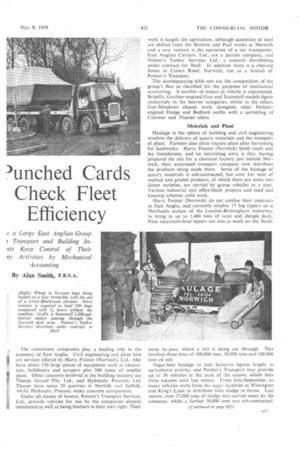
Page 50
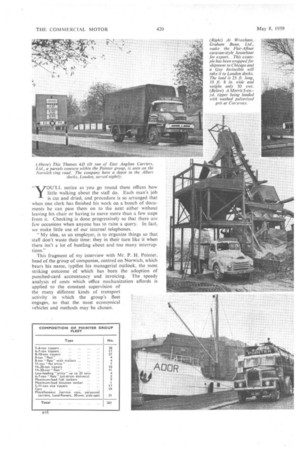
Page 52
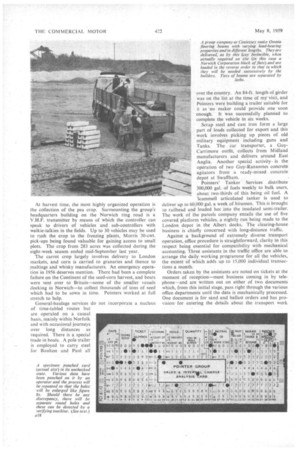
Page 55
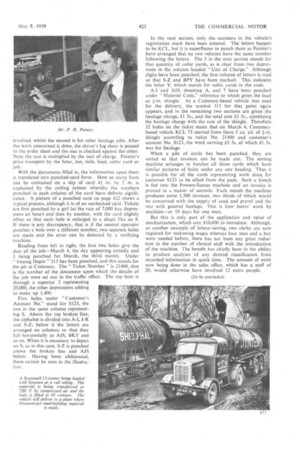
Page 56

Page 57
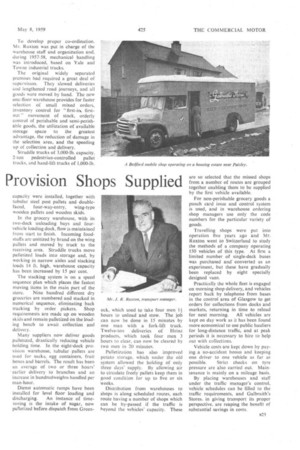
If you've noticed an error in this article please click here to report it so we can fix it.
Check Fleet Efficiency
OU'LL notice as you go round these offices how little walking about the staff do. Each man's job is cut and dried, and procedure is so arranged that when one clerk has finished his work on a bunch of documents he can pass them on •to the next either without leaving his chair or having to move more than a few steps from it. Checking is done progressively so that there are few occasions when anyone has to raise a query. In fact, we make little use of our internal telephones.
"My idea, as an employer, is to organize things so that staff don't waste their time: they in their turn• like it when there isn't a lot of bustling about and too many interruptions."
This fragment of my interview with Mr. P. H. Pointer, head of the group of companies, centred on Norwich, which bears his name, typifies his managerial outlook, the most striking outcome of which has been the adoption of punched-card accountancy and invoicing. The speedy analysis of costs which office mechanization affords is applied to the constant supervision of the many different kinds of transport activity in which the group's fleet engages, so that the most economical vehicles and methods may be chosen.
work is largely for agriculture, although quantities of steel are shifted from the Boulton and Paul works at Norwich and a new venture is the operation of a car transporter. East Anglian Carriers, Ltd., are a parcels company, and Pointer's Tanker Services, Ltd., a concern distributing under contract for Shell. In addition there is a clearing house in Crown Road, Norwich, run as a branch of Pointer's Transport.
The accompanying table sets out the composition of the group's fleet as classified for the purposes of mechanical accounting. A number of makes of vehicle is represented. Broadly, Gardner-engined Guy and Scammell models figure exclusively in the heavier categories, whilst in the others Guy-Meadows chassis work alongside older Perkinsengined Dodge and Bedford outfits with a sprinkling of Commer and Thames oilers.
Materials and Plant
Haulage in the sphere Of building and civil engineering involves the delivery of quarry materials and the transport of plant. Farmers also often require plant after harvesting for landworks. Harry Pointer (Norwich) build roads and lay foundations, and an interesting story is that, having prepared the site for a chemical factory just outside Norwich, their associated transport company now distribute the products being made there. Some of the haulage of quarry materials is sub-contracted, but over Irn, tons of washed and graded products, of which there are some two dozen varieties, are carried by group vehicles in a year. Various industrial and office-block projects and road and housing schemes yield work.
Harry Pointer (Norwich) do not confine their contracts to East. Anglia, and currently employ 17 big tippers on a Northants section of the London-Birmingham motorway to bring in up to 1,400 tons of sand and shingle daily. Nine maximum-load tippers are also at work on the Maid
The constituent companies play a leading role in the economy of East Anglia. Civil engineering and plant hire are services offered by Harry Pointer (Norwich), Ltd., who have about 150 large pieces of equipment such as excavators, bulldozers and scrapers phis 300 items of smaller plant. Other concerns involved in the building industry are Thorpe Gravel Pits, Ltd., and Hydraulic Precasts, Ltd. Thorpe have some 20 quarries in Norfolk and Suffolk, whilst Hydraulic Precasts make concrete components.
Under all classes of licence, Pointer's Transport Services, Ltd., provide vehicles for use by the companies already mentioned as well as being hauliers in their own right. Their Stone by-pass, where a hill is being cut through. This involves three bites of 100,000 tons. 50,000 tons and 100,000 tons of soil.
Sugar-beet haulage to four factories figures largely in agricultural activity, and Pointer's Transport may provide up to 30 vehicles at the peak of the season, which lasts from -autumn until late winter. From July-September, as many vehicles work from the sugar factories at Wissington and King's Lynn to distribute lime sludge to farms. Last season, over 17,000 tons of sludge was carried away by the company, whilst a further 30,000 tons was sub-contracted. At harvest time, the most highly organized operation is the collection of the pea crop. Surmounting the group's headquarters building on the Norwich ring road is a V.H.F. transmitter by means of which the controller can speak to drivers of vehicles and sub-controllers with walkie-talkies in the fields. Up to 30 vehicles may be used to rush the crop to the freezing plants, Morris 30-cwt. pick-ups being found valuable for gaining access to small plots. The crop from 283 acres was collected during the eight-week season ended mid-September last year.
The carrot crop largely involves delivery to London markets, and corn is carried to granaries and thence to maltings and whisky manufacturers. An emergency operation in 1956 deserves mention. There had been a complete failure on the Continent of the seed-corn harvest, and boats were sent over to Britain—some of the smaller vessels docking in Norwich—to collect thousands of tons of seed which had to be sown in time. Pointers worked at full stretch to help.
over the country. An 84-ft. length of girder was on the list at the time of my' visit, and Pointers were building a trailer suitable for it as -no maker could provide one soon enough. It was successfully planned to complete the vehicle in six weeks.
Scrap steel and cast iron form a large part of loads collected for export and this work involves picking up pieces of old military equipment including guns and Tanks. The car transporter, a GuyCarrimore outfit, collects from Midland manufacturers and delivers around East Anglia. Another special activity, is the operation of two Guy-Ransornes concrete agitators from a ready-mixed concrete depot at Swaffham.
Pointers' Tanker Services distribute 300,000 gal. of fuels weekly to bulk users, about two-thirds of this being oil fuel. A icammell articulated tanker is used to deliver up to 60,000 gal. a week of bitumen. This is brought to railhead and loaded hot into the insulated semi-trailer. The work of the parcels company entails the use of five covered platform vehicles, a nightly run being made to the London depot in the Albert docks. The clearing-house business is chiefly concerned with long-distance traffic.
Against .a background of extremely diverse transport operation, office procedure is straightforward, clarity in this respect being essential for compatibility with mechanical accounting. Three assistants in the traffic office are able to arrange the daily working programme for all the vehicles, the extent of which adds up to 15,000 individual transactions a month.
Orders taken by the assistants are noted on tickets at the moment of reception—most business coming in by telephone—and are written out on either of two documents which, from this initial stage, pass right through the various office departments until the data is mechanically processed. One document is for sand and ballast orders and has provision. for entering the details about the transport work involved, whilst the second is for other haulage jobs. After the work concerned is done, the driver's log sheet is pinned to the order sheet and the one is checked against the other. Next the rate is multiplied by the unit of charge. Pointer's price transport by the hour, ton, mile, load, cubic yard or job.
With the documents filled in, the information upon them is translated into .punched-card form. How so many facts can be contained ••tin " a Slip of card 41 in. by 2 in. is
explained by the coding system whereby the numbers punched in each column of the card have definite significance. A:picture of a punched card on page 422 shows a typical process, although it is of an unchecked card. Tickets are first punched by a girl (at the rate of 7,000 key depressions an hour) and then by another, with the card slightly Offset. so that each hole is enlarged to a shape like an 8. If there is any discrepancy, that is if the second operator punches a hole over a different number, two separate holes are made and the error can be detected by a verifying
machine.
. Reading from left to right, the first two holes give the date of the job—March 4, the day appearing initially and 3 being punched for March, the third month. Under ." Issuing Depot" 313 has been punched, and this stands for the pit at Costessey. The "Ticket Number" is 21400, that is the number of the, document upon which the details of the job were set out in the traffic Office. The top hole is through a superior 2 representing 20,000, the Other depressions adding to make up 1,400.
Five holes under "Customer's Account No." stand .for S123, the two in the same column representing S. Above the top broken line, the alphabet is divided into AI, J-R and S-Z; below it the letters are arranged on columns so that they fall horizontally as AJS, BKT and so on. When it is necessary to depict an 5, as in this case, S-Z is punched above the broken line and AJS below. Having been obliterated, these cannot be seen in the illustration.
In the next section, only the numbers in the vehicle's registration mark have been entered. The letters happen to be KCL, but it is superfluous to punch them as Pointer's have arranged that no two vehicles have the same number following the letters. The 5 in the next section stands for that quantity of cubic yards, as is clear from two depressions in the column. headed "Unit of Charge." Although digits have been punched, the first column of letters is read. so that S-Z and BPY have been marked. This indicates the letter Y, which stands for cubic yards in the code.
A-land AJS; denoting A, and 7 have been punched under " Material Code," reference to which gives the load as 4-in. shingle. As a Costessey-based 'vehicle was used for the delivery, the symbol 313 for that point again appears, and in the remaining two sections are given the haulage charge, £1 5s., and the total cost £.3 5s., combining the haulage charge with the cost of the shingle. Therefore 32 holes on the ticket mean that on March 4, Costesseybased vehicle KCL 73 carried from there 5 cu, yd. of 4-in. shingle according to ticket No. 21400 and customer's account No. S123, the work earning £3 5s. of which £1 5s. was for haulage.
When a pile of cards has been punched, they are sorted so that invoices can be made out. The sorting machine arranges in batches all those: cards which have similar patterns of holes under any one heading. Thus it is possible for all the cards representing work done for customer S123 to be sifted from the pack. Such a bunch is fed into the Powers-Sarnas machine and an invoice is printed in a matter of seconds. Each month the machine produces some 1,500 invoices, two thirds of which would be concerned with the supply of sand and gravel and the rest with general haulage. This is four hours' work by machine—or 10 days for one man.
But this is only part of the application and value of mechanization, which cost £10,000 to introduce. Although, as another example of labour-saving, two clerks are now required for reckoning wages whereas four men and a boy were needed before, there has not been any great reduction in the number of clerical staff with the introduction of the machine. The benefit has chiefly been in the ability to produce analyses of any desired classification from recorded information in quick time. The amount of work now being done in the sales, office, which has a staff of 20, would otherwise have involved 12 extra people. which works out at £14 10s. compared with £32 originally.
The present fleet of about 60 laries and 50 vans is predominantly Albion. The platform' vehicles are Chieftain 61-ton oilers and FT3 petrol-engined 5 tonners whilst most of the bakery vans are FT2I or AZ9 3-ton models. The petrol vehicles are gradually being replaced with a view to eventually having all oilers.
Because of -the variation of consumer demand and the large amount of perishable produce handled, speed and 'reliability are essential. Distribution from warehouse to To develop proper co-ordination, Mr. Ruxton was put in charge of the warehouse staff and organization and, during 1957-58, mechanical handling was introduced, based on Yale and Towne industrial trucks.
The original widely separated premises had required a great deal of supervision. They slowed deliveries and lengthened road journeys, and all goods were moved by hand. The new one-floor warehouse provides for faster selection of small mixed orders, inventory control for "first-ii, firstout movement of stock, orderly control of perishable and semi-perishable goods, the utilization of available storage space to the greatest advantage, the reduction of damage in the selection area, and the speeding up of collection and delivery.
Straddle trucks of 3,000-1b. capacity, 2-ton pedestrian-controlled pallet trucks, and hand-lift trucks of 1,000-lb.




































































































